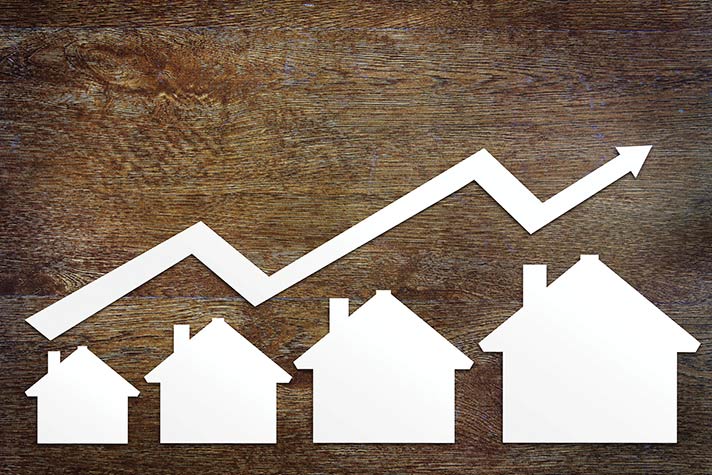Let’s Talk Real Estate – August 2021
Last year, U.S. home sales and prices soared at their fastest pace in 14 years. On a local level, we’ve seen unprecedented demand and low inventory and soaring prices. Over the last 12 months, Jackson County existing home prices increased by almost 27% and Josephine County saw prices jump by 28%. Home prices have gone up steadily since 2013, but we haven’t seen this amount of yearly price appreciation since 2005. Jackson County’s median home price is now approaching $400,000—yes, $400,000. It wasn’t very long ago that we were waiting for the median home price to hit $300,000!
The median price is an average, and in real estate, demand is always greater for lower-priced homes. Lower-priced homes below $300,000 have actually seen price increases exceeding 30%, and conversely, homes priced over $1,000,000 are likely to have seen less than a 10% increase in value over the last 12 months. Jacksonville gets the record for the highest median price home at $639,500, with Ashland coming in second at $587,500. Because homes in theses two cities sell for over the median price, they did see lower price increases; Jacksonville prices increased by 19.7% with Ashland increasing by 21.3%.
All of this is great news for homeowners but increasingly bad news for home buyers. The last few years have been difficult for buyers, but it’s getting worse. Demand is at an all-time high, with 2021 setting records for the number of homes sold and competition for homes under $400,000 is at a record high. Buyers in the under- $400,000 market are getting disillusioned. First-time home buyers, looking for homes under $300,000, have it the worst. They are experiencing lots of competition for each home they make an offer on and as each month goes by, prices are creeping up.
How long can prices keep climbing and demand keep increasing, and will we see a crash? Predicting future home sales isn’t a simple equation; it’s an intersection where demand, affordability, and the general economy all play an important role. So, let’s look at these three factors in our local market:
Demand—Last quarter’s home sales are up 27% over same time last year. With all-time-low interest rates, it’s been tempting for locals to upgrade to homes that fit their current needs, or downsize and pull out the equity for retirement. In addition, our local real-estate market has always attracted retirees, with its rural atmosphere, abundant outdoor activities and culture, but demand from post-pandemic office workers now able to work from home has accelerated. When surveyed, the majority of office workers responded that if they could work from home, they would choose a home in a smaller, rural area that has great recreation opportunities. Seems like Southern Oregon is a great fit!
Affordability—A big part of the past increase in home sales has come from all-time low interest rates allowing buyers to get more for their money. The Federal Reserve has stated that it is unlikely to raise interest rates anytime soon, so hopefully we’ll continue to see record low interest rates at least through 2022. On the other hand, the price of goods and services has skyrocketed in recent months. New construction is going to cost more with the cost of raw materials such as lumber and steel going up exponentially. On a personal note, we were working with a large builder to build an 1,100 square foot rental home in Medford on land we own, when last month we got a notice from the builder that our $130,000 bid had just increased by $30,000. That’s a 23% increase, so there goes affordability!
Economy—We have seen inflation creeping back into our economy with the cost of goods and services increasing. In June, the U.S. consumer price index rose 0.9%, rising 5.4% over the last 12 months. Some say that pandemic-caused broken supply chains are to blame, and inflation will calm down once production of goods is back to pre-pandemic levels, but they may be optimistic. On the labor front, if you own a business, it’s extremely difficult to hire right now. Everywhere you go you see “Help Wanted” signs. With wage inflation, once wages go up, they are unlikely to ever go back down.
Inflation isn’t always bad news for the real estate market, and some see it as a shelter from inflation. When prices increase for business, they can’t always pass them onto the consumer without losing market share—so corporate profits get squeezed and stock prices fall. Blackstone, one of the investment businesses I admire the most, has just invested $6 billion in real estate by buying Home Partners of America, owner of over 17,000 rental houses in the U.S. This is one of the latest signs Wall Street believes the housing market will stay hot.
What’s the conclusion? Will the real estate market continue to soar or crash? Clearly, home prices are going to continue to increase due to low supply, high demand, and the increasing cost of new construction. Inflation, which I believe is here to stay, will mean you can buy less with your dollar. First-time home buyers will have to pay more for their first home, which means they will have to make more to qualify and will ultimately lead to less first-time home buyers. But inflation also means you may see a lot more investors, such as Blackstone, invest in real estate. With 10,000 baby boomers reaching the age of 65 per day, and millions of post-pandemic office workers being allowed to work remotely, demand from these two populations will remain high and maybe increase. All in all, it looks like higher home prices and higher demand are here to stay, at least for the foreseeable future.
